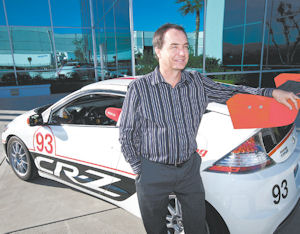Honda Performance Development, which designs and builds engines and parts for IndyCar and American Le Mans race cars, is zooming into the amateur circuit. The Santa Clarita-based racing division of Honda has diversified to support weekend racers who modify everyday passenger cars and race them against each other on tracks throughout the U.S. The move comes as Honda Performance is hitting the gas pedal to build its brand awareness, especially among Honda drivers. “There are a lot of people racing Honda products that are not aware of us,” said Kevin Henricks, the manager of business development. In the two years since its launch, the Honda Racing Line has attracted 750 competitors in multiple classes from shifter carts to the semi-pro level. That number is a fraction of amateurs who race. The Sports Car Club of America, one of two organizations sponsoring races, has more than 7,000 drivers in its Club Racing program. Total membership in the association is about 45,000. The National Auto Sport Association has about 14,000 members, including an estimated 4,000 racers. Honda Performance Development has its share of competition, including Mazdaspeed Motorsports Development. Thousands of Mazda racers have built cars to compete in a wide variety of classes within the Sports Car Club of America and the National Auto Sports Association, which host events for the sport. Among the most popular Mazdaspeed sports cars are the RX-7 and the MX-5 Miata, as well as performance sedans like the MAZDA3. TRD, Toyota’s racing division, sells high-performance parts to the consumer market. Honda Performance supports motorsport racing in two ways. The division offers individuals and racing teams phone and online technical support regarding their vehicles. It also offers parts packages that help get cars ready for the race track and give the driver an edge. These include brakes and suspension packages for the Honda Civic and a suite of parts for the Honda Fit, the compact hatchback that is a lower entry point for the non-professional. In the future, the division plans to move beyond race cars and offer custom after-market parts for non-racing models, company officials said. “We have a dream of offering performance parts for the street,” said Marc Sours, the general manager at Honda Performance Development. “Once we get to that point, HPD would be the brand to sell them under.” The starting line: Honda Performance Honda Performance Development got its start in 1993, and at first rebuilt engines and provided racetrack support to cars. Later, the company began doing its own research and development, manufacturing and sales. Extensive planning took place before Honda Performance entered the grassroots motorsports market. The company reached out to counterparts at other Honda facilities and brought on staff with racing expertise. While these engineers are not building the $250,000 engines used by the pros, their knowledge is applicable to the amateur circuit. “They understand what the track-side environment requires,” Sours said. The engineering team is currently developing a Civic engine for an open wheel racing class. Open wheel cars have a single seat with the wheels extending away from the body. Honda vehicles have become popular racing vehicles because of their reliability and affordability, with the Civic being the model of choice. The Real Time Racing team, sponsored by Honda Performance, races an Acura modified for the track. The supercharged CR-Z hybrid has an improved battery pack that reaches speeds of up to 200 mph. “We had someone build an Element for a drifting series,” Henricks said. (Drifting is a driving technique when the driver over-steers.) Another appealing factor is that a wide range of people can relate to a Honda, because it is not flashy like a Ferrari or a Lamborghini, said Dan Kahn of Kahn Media, a Reseda marketing and public relations firm specializing in the automotive industry. (Kahn’s client, Red Line Oil, also sponsors the Real Time racing team.) “Culturally, their vehicles drive sportier and tend to be more tuned to the driving enthusiast than a Chevy or Toyota sedan,” Kahn said. Indy 500 engines For the past six years, Honda Performance has supplied the engines for the Indianapolis 500. During those six years no car experienced an engine failure, Henricks said. Honda Performance is now developing a new engine for the 2012 race and will be in competition against Chevrolet and Lotus. What makes Honda Performance unique in motorsports is that it is a dedicated racing division of one of the major car manufacturers, Kahn said. It is unlike TRD, Toyota’s racing division, which sells high performance parts for cars, trucks and SUVs. “Honda leans on HPD for their technology that trickles down into a lot of cars,” he added. Sours said Honda Performance has an advantage over its main rival, Mazdaspeed, by having its design and development functions under one roof. Honda Performance has developed a reputation for its quick turnaround on orders for parts, said Jeremy Croiset, the sponsorhip manager with the National Auto Sports Association. “We had a number of racers at the NASA championship who got parts overnighted to the track to have their cars ready for the weekend,” Croiset said. Being associated with IndyCar, and the American Le Mans series made Honda Performance well known among the pit crews, company officials say. But there is still work to do to raise the company’s profile with the general public. For example, it wasn’t until the company moved into a new 130,000-square-foot building five years ago that the Honda Performance name went up on the outside, Henricks said. Building the Honda Performance brand and promoting the amateur racing support system and parts go hand in hand. So the company’s brand awareness campaign will extend into the dealerships to get the HPD name out in front of more people, Henricks said. His goal: to make the Honda Performance name synonymous with a reliable engine and the Honda expertise. “We want people to have fun and to do it cost effectively and in a reliable product for whatever their aspirations are,” Henricks said.
